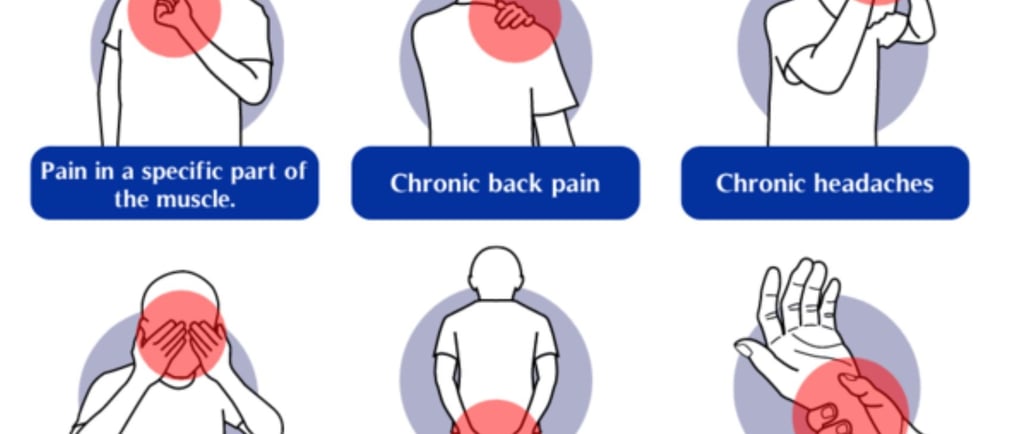When to Seek Professional Help for Office Syndrome Symptoms
Office Syndrome is a term commonly used to describe a range of musculoskeletal issues and discomforts that arise due to prolonged sitting, poor posture, and repetitive movements typically experienced in office environments. With the rise of sedentary lifestyles and extended screen time, Office Syndrome has become a prevalent condition affecting many workers. Early recognition and treatment of its symptoms can help prevent long-term damage, improve your quality of life, and promote a healthier work routine. Here's when you should consider seeking professional help for Office Syndrome symptoms:
12/30/20245 min read


Office Syndrome is a term commonly used to describe a range of musculoskeletal issues and discomforts that arise due to prolonged sitting, poor posture, and repetitive movements typically experienced in office environments. With the rise of sedentary lifestyles and extended screen time, Office Syndrome has become a prevalent condition affecting many workers. Early recognition and treatment of its symptoms can help prevent long-term damage, improve your quality of life, and promote a healthier work routine. Here's when you should consider seeking professional help for Office Syndrome symptoms:
1. Persistent Pain or Discomfort
One of the earliest signs of Office Syndrome is persistent discomfort or pain in areas such as the neck, shoulders, back, or wrists. Initially, this may be a minor ache that comes and goes, but if the pain becomes more constant or worsens over time, it's time to consult a professional.
When to Seek Help: If you experience consistent pain that doesn’t subside with rest, stretching, or changing your posture.
Potential Causes: Chronic muscle strain, poor ergonomics, and repetitive stress on muscles and joints can lead to conditions like cervical spondylosis, tendinitis, or carpal tunnel syndrome.
2. Reduced Range of Motion
If you're finding it difficult to move your neck, shoulders, or arms as freely as before—due to stiffness or pain—this can be a sign that the condition is worsening. A reduced range of motion might prevent you from performing basic tasks like turning your head or reaching for objects.
When to Seek Help: If stiffness or limited movement persists for days or gets progressively worse, consult a healthcare professional.
Potential Causes: Muscle tightness, joint inflammation, or damage to tendons and ligaments from repetitive movements or poor posture.


3. Frequent Headaches or Migraines
Headaches are a common symptom of Office Syndrome, particularly those stemming from neck and shoulder tension. Tension headaches or migraines caused by poor posture and muscle strain can significantly affect your ability to focus and be productive.
When to Seek Help: If you experience headaches that occur regularly, are accompanied by neck or shoulder pain, or last longer than usual.
Potential Causes: Tight muscles in the neck and upper back can strain the surrounding areas, leading to tension headaches. This can be a sign of cervicogenic headaches or tension-type headaches.
4. Numbness, Tingling, or Weakness in Limbs
Numbness or tingling in the hands, fingers, or legs, as well as a sensation of weakness, can indicate nerve compression, which may be caused by poor posture or repetitive stress injuries. Conditions like carpal tunnel syndrome or thoracic outlet syndrome are common in office workers who spend long hours at a desk.
When to Seek Help: If you experience numbness or tingling that persists beyond a few minutes, or if these sensations affect your ability to use your hands or walk.
Potential Causes: Compression of nerves due to prolonged sitting, poor posture, or repetitive motions. In severe cases, this could lead to nerve damage.
5. Persistent Back Pain
Lower back pain is a hallmark of Office Syndrome, often due to poor posture, long periods of sitting, and inadequate lumbar support. If left untreated, persistent back pain can lead to more serious conditions like herniated discs, sciatica, or chronic lower back strain.
When to Seek Help: If your back pain is severe, doesn't improve with rest, or has lasted for more than a week. Additionally, seek help if you experience pain that radiates down your legs.
Potential Causes: Sitting for extended periods without proper lumbar support or ergonomic adjustments can lead to compression of the spine, weakening of back muscles, and nerve irritation.


6. Visual Disturbances or Eye Strain
Spending hours staring at a computer screen can cause computer vision syndrome (CVS), also known as digital eye strain. This can lead to symptoms like blurred vision, dry eyes, headaches, and neck or shoulder pain. If left unchecked, these issues may worsen and affect overall comfort.
When to Seek Help: If you experience blurry vision, difficulty focusing, or eye discomfort that doesn’t improve with regular breaks or adjusting screen settings.
Potential Causes: Prolonged screen time, improper lighting, and poor posture can strain your eyes and exacerbate the discomfort.
7. Difficulty Sleeping or Insomnia
Chronic pain, discomfort, and stress from Office Syndrome can negatively impact sleep quality. If the pain interferes with your ability to sleep or causes you to wake up during the night, it’s time to seek professional help.
When to Seek Help: If your symptoms are affecting your sleep regularly or causing you to wake up in pain.
Potential Causes: Chronic musculoskeletal pain and poor posture during sleep can disrupt your sleep cycle, leading to insomnia or poor-quality rest.
8. Decreased Productivity and Concentration
Office Syndrome can directly impact your ability to focus or perform daily tasks. If you find yourself distracted by discomfort or pain, leading to decreased productivity or difficulty concentrating, this may be a signal that professional intervention is necessary.
When to Seek Help: If you experience a decline in your ability to focus at work, especially when accompanied by pain or physical discomfort.
Potential Causes: The physical strain of poor posture and repetitive movements can affect cognitive function and concentration.
9. Chronic Fatigue
Chronic pain and discomfort from Office Syndrome can leave you feeling drained and fatigued, even after a full night's sleep. The mental and physical toll of persistent discomfort can contribute to exhaustion and a lack of energy.
When to Seek Help: If fatigue becomes chronic, affecting your daily routine or overall quality of life.
Potential Causes: Ongoing pain and discomfort can lead to physical and emotional exhaustion, which in turn affects your energy levels and motivation.
10. Failure to Improve with Home Remedies
If you’ve tried home remedies—such as changing your workstation setup, taking frequent breaks, using heat or cold packs, or doing stretches—and your symptoms persist or worsen, it’s important to consult a healthcare professional.
When to Seek Help: If your symptoms don’t improve with self-care measures or worsen over time.
Potential Causes: More serious underlying conditions such as nerve compression, musculoskeletal injury, or chronic muscle strain that require professional treatment.
Conclusion
Office Syndrome symptoms may start off as minor discomforts, but if left unaddressed, they can escalate into more serious, long-term issues. If you experience persistent pain, reduced mobility, or any of the other symptoms listed above, seeking professional help is crucial to prevent further damage and improve your overall wellbeing. A healthcare provider, such as a physical therapist, chiropractor, or orthopedic specialist, can provide a personalized treatment plan tailored to your specific needs and help you return to a pain-free, more comfortable work routine.
Resources
Comprehensive information, practical tips, effective solutions, workplace health
Office Syndrome & Well-being
© 2024. All rights reserved. Designed by Pimclick - SEO Agency
Effective Exercises and Stretches for Relief
The Role of Workplace Wellness Programs
